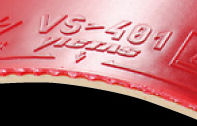
A detailed review of the new Victas VS> 401 rubber, an extremely spinny rubber, suited particularly well for modern defender style, i.e. players that chop with heavy backhand, but also attack upon opportunity.
The review covers comparisons of all 3 thicknesses that this rubber is made in, 1.5mm, 1.8mm and 2.0mm.
Here is the description from Victas:
The new VICTAS VS > 401 rubber offers the perfect balance between a tacky control rubber and a variable offensive rubber. The German and Japanese material experts (GJ Tec) developed an extremely tacky surface for vicious backspin forcing your opponent into mistakes.
The slightly more compact sponge neutralizes your opponent’s attacks, thus providing for fantastic control. The High Energy Tension top rubber sheet also offers sufficient speed for sudden and dangerous attacks. VS > 401 is the perfect tool for all-rounders who need sufficient power for their own attacks in addition to great control.
Victas is an extension of the TSP company, one of the major Japanese table tennis manufacturers in Japan. It is led by my Koji Matsushita (pictured right), a defensive player, and one of the greatest players ever from Japan.
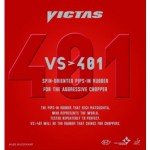 Although the design is Japanese, the rubber is manufacturerd in Germany, presumably by ESN, the manufacturer of all major German rubbers. Packaging is shown on the right. The rubber is well packaged in carton & plastic, with a paper protection sheet on the topsheet, like most modern rubbers from Japan or Germany.
Although the design is Japanese, the rubber is manufacturerd in Germany, presumably by ESN, the manufacturer of all major German rubbers. Packaging is shown on the right. The rubber is well packaged in carton & plastic, with a paper protection sheet on the topsheet, like most modern rubbers from Japan or Germany.
Visual Inspection
Here are some pictures of a brand new sheet of 1.5mm black (click to zoom in). AS you can see, the sheet is of very high quality, as can be expected from TSP and other major Japanese manufacturers.
The topsheet is mildly tacky but feels fairly soft and elastic. The sponge is quite firm, quoted as 57deg, which is very firm for a German-made rubber, but still softer than many Chinese-made rubbers.
Pores of the sponge are not big like some of the modern rubbers, but still bigger than the old traditional sponges.
By pulling apart a cut-off, we can see the shape and size of the pimples. Removal of the sponge was very hard, as the sheet is glued together very well!
What’s interesting to note is that the pimples are quite short and somewhat wides than most modern offensive rubbers. Generally longer pimples are usually better for spin for loops, whereas short and wider pimple offer more control and stability. Obviously there are exception to this, as there are many other properties of the sponge and topsheet contribute to both these characteristics.
Testing the rubber in play
I’ve tested this rubber in all three of the thicknesses that it comes in, but all in black. Tests were done on my regular Re-Impact Smart blade, a relatively thick balsa combination blade, which is probably rated around OFF for the forehand. Backhand is much slower and has long pimples (Tibhar Dtecs OX). This is my usual combination, so I’m very familiar with the blade and it’s characteristics, so I’m in a good position to isolate the characteristics of this rubber.
Chopping
The main reason I wanted to try this rubber was because I wanted to chop with heavy backspin more away from the table. This is something I wanted to add to my game, as I often found myself away from the table.
I started with the 1.5mm version, and chopping with this rubber was a breeze, and very very spinny. This rubber was clearly designed for a chopper, and it was quite forgiving against spin, and really allowed me to load up with my own backspin. Coming from other high spin rubbers, like JUIC 999 Turbo and Grip-S Euro, this was easily the best for chopping and as spinny as the other rubbers.
Pushing and Serves
Although the tack of this rubber was quite mild, serves and pushes could be made with very high spin, as much as the really tacky rubber, which usually give me the most spin.
The bit that surprised me a little was that the topsheet felt quite slow on soft contact, like an almost dead feel, which allowed me to really load up the spin while keeping the ball very short. It was clear from the first few serves that I played, that the same serve was going shorter, making double-bounce serves a lot easier.
Pushes were also very spinny when I wanted to, and again the dead feel was there, making the short game very good and forgiving. The rubber is a little more sensitive to incoming spin than some of the more popular non-tacky rubbers like Tenergy 80 for example, but still clearly less sensitive than tacky Chinese rubbers.
Looping
My biggest concern with rubbers that are designed for defensive styles, is that they don’t perform well for looping and other attacks.
First I tried opening up against backspin balls with a slow spinny brush loop (my favourite shot on forehand!). Results were a medium pace extremely spinny shot. Spin was as high as with my current favourite tacky rubbers… perfect so far!
Although the sponge is quite firm on this rubber, the topsheet feels soft and elastic, making the whole rubber feel a lot softer. Slow spinny loops gives the slingshot-type feel, where the ball grabs the topsheet, stretches it, and then kicks it out with high spin. I get similar feel with JUIC 999 Turbo and Grip-S Euro, and I really like this feel, and it’s great for slow spinny loops.
As I started looping harder I could feel the effect of the sponge/topsheet combination kick in, giving quite a boost in speed, considerably more than you get from Chinese sponges. Although the balls were still very spinny at medium pace, as I started looping harder the spin reduced and the path flattened out. This is of course to be expected from a 1.5mm rubber, where the sponge starts bottoming out at higher impact.
This led me to try the same rubber with a thicker sponge. First I tried the rubber in 2.0mm. I was surprised how much more lively this was, especially since I normally play with max or 2.0mm rubbers. Although looping was really nice and very spinny even for hard powerloops, chopping was clearly not as controlled, and neither was the short game.
Now it should be noted that some of this can be attributed to my blade, as Re-Impact blades get quite a lot of kick on higher impact, and usually rubbers no more than 1.8mm are recommended. So on a regular blade I expect it to be more controllable and the difference in control less significant.
This led me to try the 1.8mm, which was a perfect compromise on my blade. For chopping and the short game, the rubber was very good, and only slightly less controlled than 1.5mm. For looping it was very spinny with good speed, and spin did not reduce significantly at higher pace… it was perfect for my own game!
Blocking
Blocking has always been the weakest part of my game, as I often struggle to control high spin and high pace. I did not expect this rubber would change this much, but to my surprise this rubber greatly improved my blocking ability.
When blocking passively, the slower topsheet seems to absorb quite a lot of the pace, while it seems quite insensitive to spin, not unlike non-tacky rubbers. This made it real easy to block fast and spinny loops.
When you block more aggressively the sponge gives you really good pace, and it’s still insensitive to spin. It’s quite remarkable how much easier this rubber made my blocking.
I suspect the improved blocking ability and accuracy can be attributed to the shorter pimple structure on the bottom of the topsheet as described above. This is supposed to give the rubber more stability, but it really surprised me how well this worked.
Hitting
For hitting (flat) the rubber behaves very much like a non-tacky rubber. Accuracy is good and it’s relatively insensitive spin.
Counter-looping
For those of you that play with tacky rubbers, like most Chinese rubber, you’ll know that it’s quite difficult to counter-loop a spinny loop close to the table, as the harder you loop, the more the ball bites, making it very hard to keep down. This is unlike Tensors and rubbers like the Tenergy series, which seems to drop the ball down (lower throw) when you counterloop, making this very much easier and highly effective if you’re quick enough to do it.
Although the Victas VS>401 plays more like a tacky Chinese style rubber in most aspects (with some exceptions outlined above), counter-looping spinny loops is more like non-tacky and non-Chinese rubber, as the ball does drop down.
For my own game this was quite a bonus, as I always struggled with slow and higher spinny loops, which either forced me to smash them while adjusting for the spin, or chop then while taking a step back. I can now counter-loop these balls.
I know some of this can be attributed to the fact that this rubber is only 1.8mm, which will always drop the throw at high impact somewhat as the sponge starts to bottom out. Still it’s very nice property to have.
Durability
I’ve used the same rubber for my own competition for about 3 months now, and the rubber is still in good condition. This is better than my experience with German rubber, which usually last me about 6-8 weeks, and similar to some of the more durable Chinese rubbers.
I do look after the rubbers very well, keeping them clean all the time with water, giving them as extra clean with a foam cleaner at least once a week, and the occasional restore with the Falco Expander. I do use these same products for all my rubbers, so the comparison in still valid.
Something I did also notice is that the sponge seems to soften up significantly after a couple of sessions, allowing you feel the ball onto the blade a little more, and also making the distinct speed glue effect sound more obvious, which can be hard to hear with firm Tensor-type sponges.
Conclusions
For my own game, this is easily the most ideal rubber I’ve ever found, as it combines those properties that I need most for my game, from both Chinese and non-Chinese style rubbers. If you like to chop the ball, and like high spin you’ll probably like this rubber a lot like I did.
One thing is for sure, this rubber is quite unique and the design shows some real innovation, unlike many of the other new rubbers coming onto the market, which seem mainly aimed at competing with the most popular rubbers from other brands.
If you mainly chop and only perform slow high-spin brush loops, and/or flat hits, then 1.5mm is recommended. If you loop more I’d recommend the 1.8mm, and if you mostly attack I’d go for the 2.0mm. For Balsa blades, which tend to have a soft & springy feel, I’d recommend no more than 1.8mm.
I’m now quite keen to try the other Victas rubbers, as they keep adding to their range.
Let me know if I’ve missed anything, or if you have any questions.


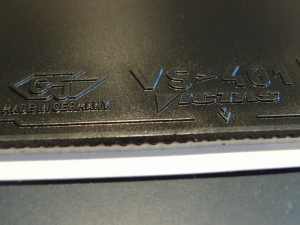

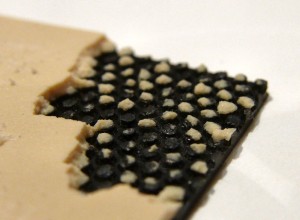
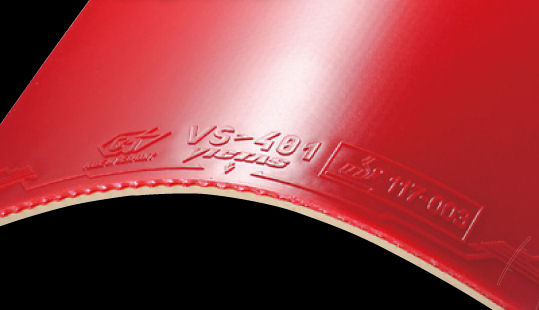
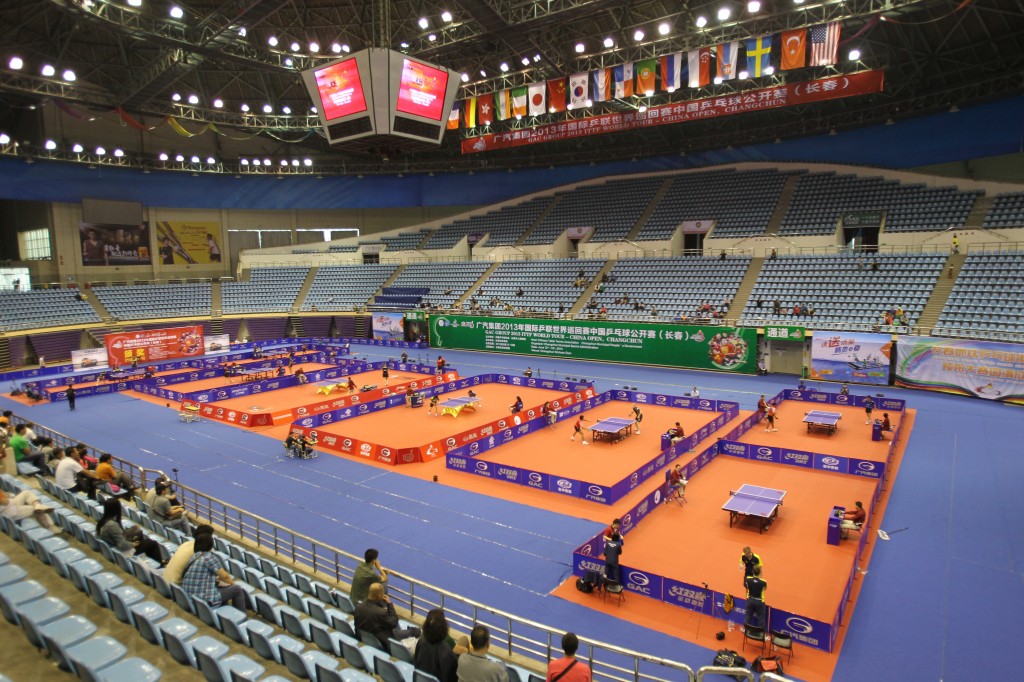
Thanks admin. I’m tempted to try the 1.5 401 on the BH as push and drive are my favoured strokes. It sounds like the 1.5 will provide excellent spin on the pushes and sufficient speed for the drives while offering good placement control on both.
So for a ALL+/OFF FH style, should I try the 1.8 401 or a variant with soft rubber, maybe in a 2.0mm?
Cheers, and thanks for the reply.
I’m curious why you suggested the 402 limber rather than the 402 DE as an alternative. Have you played with both? What the real-world difference?
The 401 is amazing for spin, and offers great control especially with a thinner sponge (1.5mm is best for control). As with most spinny rubbers though, it’s sensitive to incoming spin. A thin sponge certainly makes it easier (especially on a balsa blade which kicks hard on high impact making it less sensitive to incoming spin), so a 401 in 1.5mm might work.
The 402 Limber might be an option too. It’s not quite as spinny, but still spinny (more than mark V), and the soft sponge makes blocking a lot easier.
It has been while since this review and the last comments. I have been looking for the ideal rubber for some time yet have only just discovered this. I’m still not sure if it, or maybe the 402DE is what I need.
I use a fairly stiff, combo balsa blade. My BH games relies mainly on pushing, blocking and counter-hitting/drive. My blocking is good on low to medium top spin but not so good against high spin, always going high and long. I’m not much of a BH looper and my BH chop is terrible atm. My FH game is mainly active blocking, and loop attacks using a variety of spin and speed with some pretty good pushes and close to the table chopping and my FH lobbing is OK.
I want BH rubber that gives great control and spin while being somewhat impervious to incoming spin (my side spin service returns are terrible on both sides. It needs to have enough speed for a surprise counter hit or flick. On my FH I’m after a mid speed, high spin and controllable rubber. Since I use a Balsa blade I don’t need any/much catapult effect and need a fairly hard sponge.
I’ve tried quite a few already and my current favourite is the good old Mark V series but is the the new rubber for me? Opinions?
many thanks
I would recommend 1.5mm Kevin. You really only need thicker if you want to attack a lot.
Thanks Michael!
I agree very much with your findings. I’m also still using this rubbers after several years, and although I keep trying new rubbers, I always come back to this one.
I have been using this rubber on my BH for 11 months now and on my 3rd sheet and I love it.
The hard sponge gives me loads of control.
It is brilliant for blocking.
Pushes and chops have lots of backspin and the hard slowish sponge means you very rarely over hit.
Loop are the same very spinny.
This isn’t an out and out attacking rubber. If that is your game then this rubber isn’t for you.
This is an exceptional rubber for someone with an all round game, who likes to win points by rallying. Chop, push, loop and block all work very well with this rubber.
Hi Michael can you tell me what thickness you use for the 401 on your backhand!
I want to use it for chopping blocking and occcasional flicks and have an all round plus blade as i loop attack on my forehand and like to move my opponents around with push and blocks on my backhand
Just need advise on whether 1.5mm or 1.8mm as want control and I stay Close to table
Any advise would ne great
Thanks
Kevin
I know you reviewed this rubber over 2 years ago. But are you still using it. I have been playing for 50 years at a reasonable standard. In recent years I have ended up using faster and faster set ups. To compensate for my age as my energy levels start to drop. I have now decided that I have been going the wrong way. I can play various ways from, blocking, counter hitting. To all out aggressive attack. But the best part of my game was always my ability to keep the ball in play regardless of the type of game my opponent used. The very fast Tensor rubbers on a Carbon blade I have been using the last 2 years, gives me better attacking options but I find I’m am losing out on control side. I have read good reviews on this rubber. My friend who is a very good combination bat defender uses it in 1.5mm and twiddles. He is gets enormous amounts of spin on serves and chops. Very spinny and slow and low bounces. This is really messing up attackers of his standard. I have purchased a sheet of black in 1.8mm for my carbon blade which I intend to use on my backhand. This should hopefully give me more control with serves returns and the short game. I also like to open up with a spinny backhand loop, so I am hoping the extra spin will give my shots a bit more kick. I found with tensors that the backhand loop seems spinny when it leaves the bat, but seems to lose it’s fizz somewhere and is just a normal topspin. I think this is the problem with trying to loop with Tensors. They are to fast so the ball is leaving the bat so quickly it’s hard to really load the spin up. I have already glued it to my blade and I am hoping to get a knock on Friday evening, that’s if other tt player are allowed out to play this close to xmas. When I tested it with just a ball and the carpet. I seems like there is more spin than any other rubber I have used in the last 50 years. Whether looping or chopping. I am hoping this is the wonder rubber I have been looking for. How are you finding it, if you are still using it.
Love the chopping but it also gives me great control in return placement.